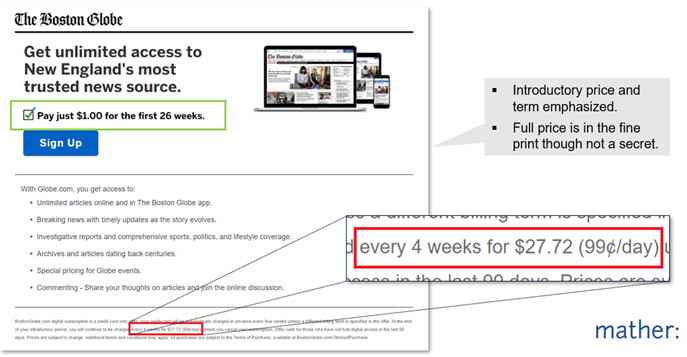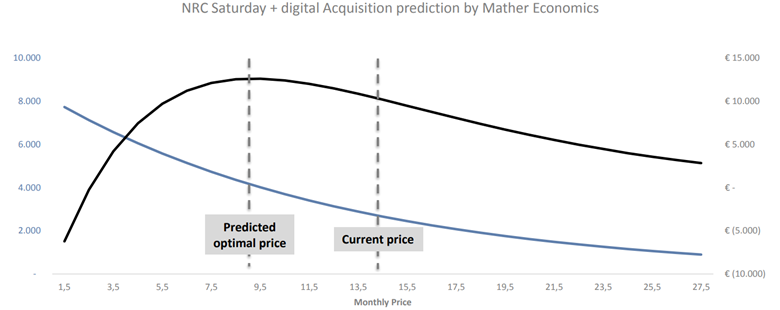Satisfying Audiences Blog | 12 April 2022
SUMMARY: The lifetime value North Star and optimization framework help marketers make critical decisions based on maximizing revenue opportunity.
By Arvid Tchivzhel, Nick Truitt, and Matt Lindsay
This is a summary of Mather Economics’ latest findings on digital subscription offer optimisation stemming from extensive economic modeling and A/B testing of subscription offers and audience segmentation. It is an overview of the topic and research approach. Additional findings may be shared in the future about developing the framework for optimising go-to-market offers and measuring trade-offs in short-term versus long-term goals.

Some media companies have adopted low introductory prices with aggressive increases.
Why lifetime value (LTV) should be your North Star
In developing an acquisition and retention strategy, publishers are often challenged with these questions:
- How do I grow starts who wont immediately churn?
- What price will get me both volume and revenue?
- Should I offer free trials or paid trails?
- What is the right length of time for the intro period?
- Once the intro expires, what should the full rate be?
These questions all seek to elevate one metric over another. Which is most important: volume, revenue, or annual revenue per unit (ARPU)?
Of course, this is not a strategic approach to maximising your subscriber opportunity, and it is not the right question to ask. Any publisher would immediately want to maximise all of these — if only it were that simple!
The relationship between an introductory price and start volume is obvious, as is the relationship between ARPU and churn. However, these should not be standalone relationships. LTV aligns all subscriber performance metrics under a single North Star.
The right question to ask, therefore, is: How do I maximise my long-term aggregate lifetime value? By framing the question in terms of LTV, publishers can unchain themselves from the pendulum swinging between volume and ARPU, or the pendulum between churn and starts.
Performance indicators like conversion rate, repeat visitors, known users, and churn are indeed still important metrics and should be closely tracked with a clear target each month. Rather than separate goals (or, at worst, competing goals), the parameters and relationships work together with a unified goal across the organisation. Decisions about introductory price, introductory term, step-up pricing, and other factors all become quantifiable levers and relationships that impact the LTV metric.
How to measure LTV
There are several ways to calculate LTV. Most methods reach similar outcomes even if some of the math and baseline figures may differ.
In summary, LTV is the expected cumulative three-to-five-year operating margin from a subscriber, given their introductory price, introductory term length, predicted retention, and planned price changes. Subscriber lifecycle management tactics may influence the expected LTV, such as the frequency and magnitude of price increases, churn reduction tactics, product changes, and digital engagement campaigns.
When optimising go-to-market offers for subscribers, we hold these other factors constant to isolate the offer parameters (such as introductory price, introductory term, and full price).
Turning math into decisions
The LTV framework is ideal for forecasting the net outcome of volume, revenue, and ARPU from potential tactics. For example, understanding price elasticity (both acquisition price and renewal price) and the effect of offer terms on retention enables the optimal balance of conversion rates and average revenue for trial offers (the quality/quantity tradeoff). Using LTV, publishers can understand how the levers they have the power to pull (usually price and term) influence outcomes directly or indirectly.
Furthermore, in the context of offer optimisation, connecting the dots between levers, relationships, and outputs requires accurate data and benchmarks to build the LTV framework. Optimisation algorithms can determine the best levers and relationships to maximise expected revenue. Mather has developed the LTV framework and optimisation algorithms in collaboration with publishers and are actively applying these tools in-market.
Putting it all together
The application of this framework and rigorous testing has led many publishers to adopt low introductory offer prices with long terms and aggressive step-up prices (for example, USD$1 for the first six months that renews to USD$1 per day). The Boston Globe and The New York Times are well-known leaders in this area. A broad survey of publishers adopting this acquisition strategy is shared by Greg Piechota in a recent INMA article.
Several years ago, NRC Handelsblad in Amsterdam found optimal acquisition prices to be lower than its traditional offer, though, at least for now, it has not been as aggressive as other publishers with its acquisition pricing. Price is one of several levers publishers can use to maximise start volume, and it is often deployed when publishers reach a plateau of subscriber volume using other tactics.

Mather has shared several case studies of applications of LTV over the years including in the hospitality industry and selling long-term subscription offers.
LTV for marketing optimisation
Market opportunity and subscription maturity (saturation) are also important to understand when determining what subscriber lifecycle management tactics to consider. For example, in the first year of launching a new digital subscription, publishers may not want to introduce deep discounts until they have maximised starts from the “low-hanging fruit” of loyal readers on their site.
As digital subscriptions plateau, tactics such as more aggressive metres, higher proportions of subscriber-only content, or registration walls can continue driving acquisition volumes while maintaining ARPU.
Beyond the use case of offer optimisation, marketers routinely develop marketing initiatives to nudge consumers into changing behaviour. In each case, the LTV North Star and optimisation framework help marketers make critical decisions based on maximising revenue opportunity.
Our work with clients in this area is extending the framework as well as the metrics and benchmarks to measure the performance of the optimised go-to-market offers.


